
Irrigation Research Projects and Studies
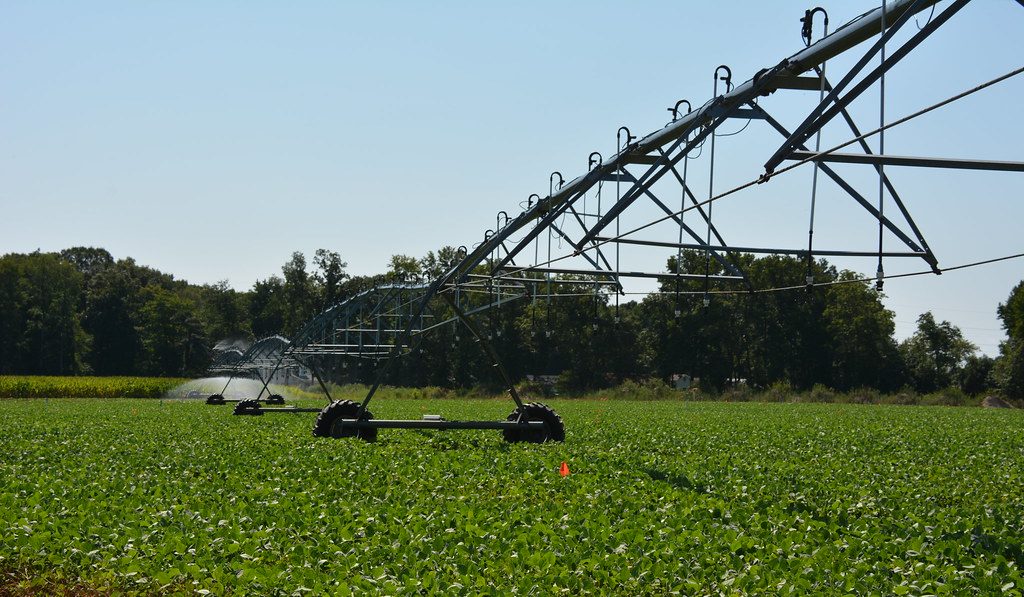
Irrigated Corn Research
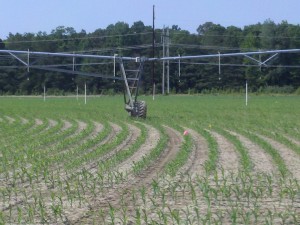
Research
One of the first tasks assigned to the irrigation research team by Delaware farmers was to answer the decades old question of how to best irrigate corn on sandy soils for maximum yield. Our initial research began using an evapotranspiration (ET) based schedule to determine when the crop should be irrigated, and looked at applying the water in varying amount per application. The application rates during peak water use were 0.33″ per day vs. 0.66″ every other day vs. 1′ every three days. The results of the initial work was rather inconclusive as soil type appeared to make more of a difference than application method. At this point, it became obvious to begin looking at varying amounts of irrigation across a range of soil types.
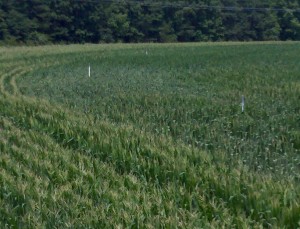
Summer study
For the Summer 2012 study, we were fortunate enough to acquire a variable rate irrigation control for the four tower center pivot located at the Warrington Farm. This controller permits the individual control of each nozzle on the pivot (85 in all) based on field location. With this new equipment capability, we are now able to apply very specific irrigation amounts to to relatively small (100′-200′ x 60′) plots.
The field was then divided into five “tiers” of ranked (20% wettest/heaviest soil, 20% driest/lightest soil and three intermediate levels) soil types based on historical aerial images. These tiers were used as the five individual replications of each irrigation treatment.
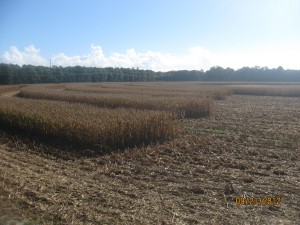
Within each soil type tier, 9 irrigation treatments were maintained throughout the season. The treatments included:
- Evapotranspiration based schedule using a 50% managed allowable depletion.
- Soil moisture triggered at 20 centibars for the full season.
- Soil moisture triggered at 30 centibars for the full season.
- Soil moisture triggered at 40 centibars for the full season.
- Soil moisture triggered at 50 centibars for the full season.
- Soil moisture triggered at 20 cb from emergence to V16; 40 cb from V16 to R3; and 20 cb from R3 to maturity.
- Soil moisture triggered at 40 cb from emergence to V16; 20 cb from V16 to R3; and 40 cb from R3 to maturity.
- Soil moisture triggered at 30 cb until R5.
- Soil moisture triggered at 30 centibars until half milkline.
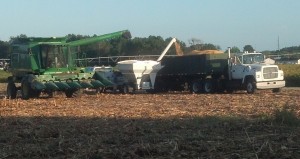
Soil moisture levels
All of the plots were planted with a Kinze 3660 12 row 30″ vaccum planter at using Dekalb 63-14 at 34,000 seeds per acre. Three tons/acre of broiler litter and 90lbs/acre of Potash (0-0-60) was applied prior to chisel plowing the field. An additional 35 lbs of nitrogen was applied in a 2″ x 2″ band at planting followed by a 50 lbs/acre sidedress application and 3-25 lbs/acre applications through the irrigation system (fertigation).
The soil moisture levels in each of the 45 plots will be continuously monitored by a Watermark 950T (Irrometer Co. Riverside, CA) wireless soil moisture monitoring transmitter. Each transmitter will collect soil matric potential values from three Watermark matric potential sensors placed at 6″, 12″, and 18″ and transmit the data to a central logger approximately 15 times per day. For each treatment, irrigation will be initiated when soil moisture at 6″ reaches a specific threshold soil matric potential. Soil matric potential at the 12″ and 18″ depths will determine the volume of irrigation applied.
The volume of water applied to each plot was recorded and summed over the whole season and during each applicable growth period (as outlined for treatments 5-8). Corn grain was harvested from each plot at maturity. Grain yield from each plot was determined using a weigh wagon and the on-board combine yield monitor. Grain weight was adjusted for moisture content prior to analysis. Data is currently being analyzed using appropriate statistical methods to determine the effects of irrigation schedules on the amount of water applied and grain yield. Results from this study will be used to adjust UD soil matric potential recommendations for irrigation management with the results of the first year of study becoming available in January.
Soybean Irrigation Response Study
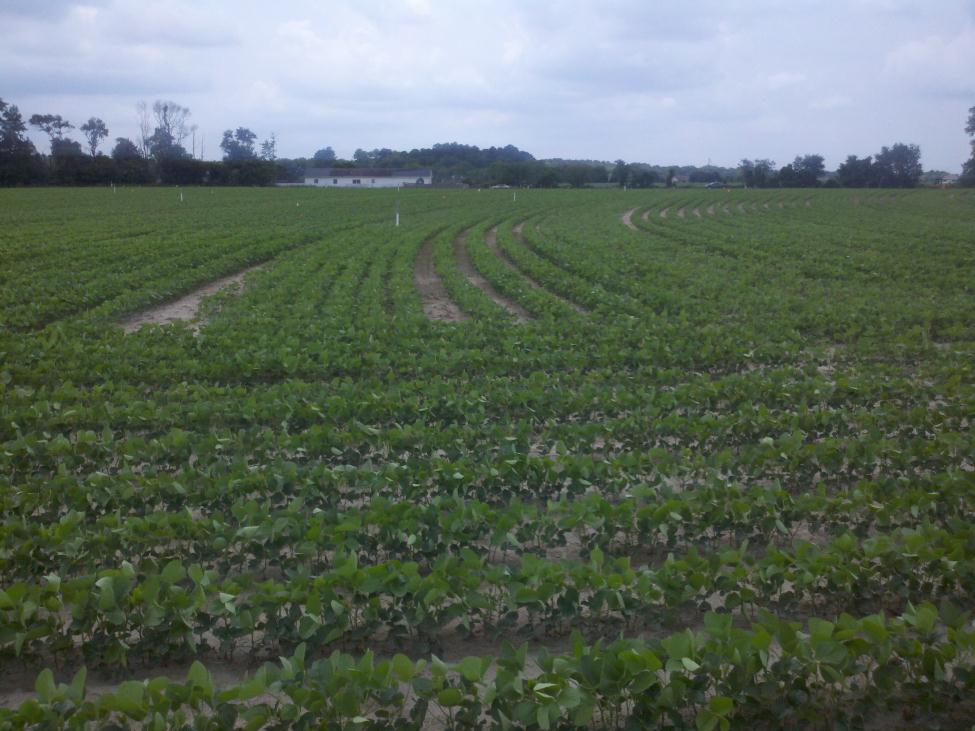
Objectives
- Evaluate the effects of various soil moisture levels and row widths on growth and yield of full season and double cropped soybeans.
- Determine the optimal irrigation management strategy for full season and double cropped soybeans to maximize yield and profitability.
- Determine the optimal row width for irrigated full season and double cropped soybeans to maximize yield and profitability.
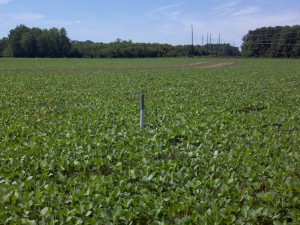
Two studies will be conducted to determine the response of full season and double cropped soybeans to various soil moisture levels and row widths. There will be a full season soybean and a double cropped soybean study. The entire study area will be treated identically for all production inputs except irrigation. Fertilizer will be applied based on the University of Delaware recommendations for soybean.
One soybean variety will be planted Mid-May for the full season study and one variety will be planted Mid-June for the double cropped study. In both projects, plots will consist of soybeans planted in 7.5″, 15″, and 30″ row widths. Each plot will receive one of the following potential irrigation treatments and will be replicated five times.
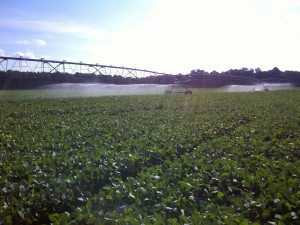
- No irrigation
- Full season irrigation (>50% soil moisture throughout the season)
- No irrigation until flowering (R1 to R2) then >50% soil moisture
- Limited irrigation (>30% soil moisture) until flowering (R1 to R2) then >50% soil moisture
- Limited irrigation (>30% soil moisture) until pod development (R3 to R4) then >50% moisture
- Limited irrigation (>30% soil moisture) until seed development (R5 to R6) then >50% soil moisture
- Limited irrigation (>30% soil moisture) until flowering (R1 to R2) then >50% soil moisture until pod development (R3 to R4) then >70% soil moisture
- Evapotranspiration (ET) based irrigation management using the Delaware Environmental Observing System’s weather station located on the research farm and the commonly accepted soybean crop coefficients
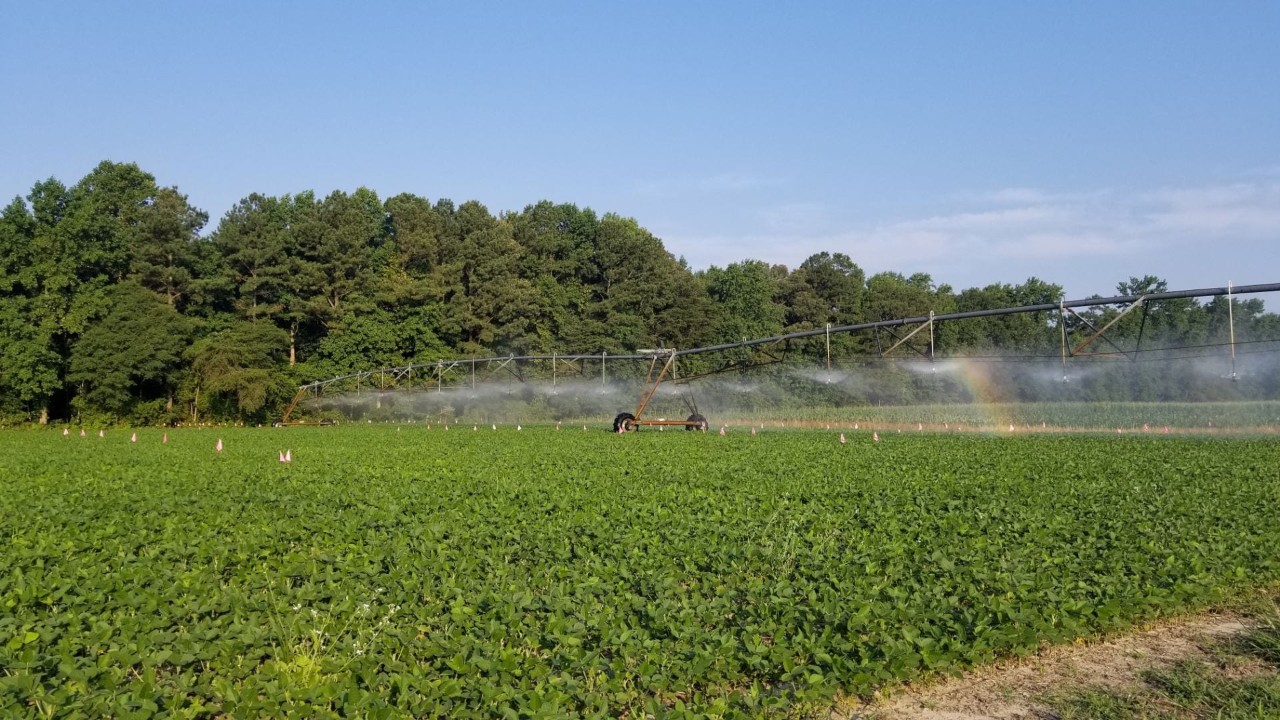
Soil moisture will be monitored in each plot in the 15 in row width using Watermark soil moisture sensors placed at 4 in, 10 in, and 16 in below the soil line. Soil moisture data will be transmitted wirelessly approximately 10 times daily from the field to a data logging receiver. Moisture data will be viewed and interpreted daily to determine if any treatments require irrigation. Irrigation in plots will be triggered whenever soil moisture reaches the specific treatment requirements at the 4 in or 10 in depth. Weather data will be collected by a Delaware Environmental Observing System weather station located on the irrigation research farm.
The plant growth and development data will be analyzed to determine the effects of soil moisture levels and row spacing on plant growth and development. In addition, soil moisture data will be analyzed to determine differences in soil moisture depletion between irrigation treatments. Total water applied for each irrigation treatment will be determined and the economic implications of each irrigation management strategy will be calculated based on soybean yield.
Irrigated Lima Bean Yield & Quality
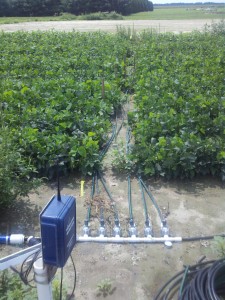
Research
Research will be performed to determine the ideal irrigation management strategy for lima beans. An automatic irrigation control system will be utilized to schedule irrigation based on actual soil moisture levels. Yield and quality differences will be compared across 4 irrigation treatments and the economics of each intensity level will be determined and shared with producers. Irrigation research for baby lima beans will be performed on the University of Delaware, Research and Education Center farm in Georgetown.
The field trials will have 4 replications of two varieties of baby limas (one less stress tolerant and one more stress tolerant) with four irrigation treatments (8 plots total per replication). Plots will be two rows, 25’ in length.
Irrigation will be provided by two lines of low flow (0.22 gpm/100’) drip tape per plot.
Treatment
Irrigation treatments will consist of:
Treatment 1 – No Irrigation
Treatment 2 – Irrigation will be triggered when the plant available water (PAW) reaches 50% of capacity throughout all crop stages; irrigation will be interrupted when the soil reaches field capacity (100% available water).
Treatment 3 – Irrigation will be triggered when the PAW reaches 35% of capacity throughout all crop stages; irrigation will be interrupted when the soil reaches field capacity (100% available water).
Treatment 4 – Irrigation will be triggered during vegetative growth stages at 35% of PAW followed by a 50% PAW trigger during reproduction.
Watermark 950T matric potential sensors will be placed at 4”, 12” and 18” depth within each plot and will be hard wired to a Campbell CR 1000 data logger. The data logger will collect and record the real time soil moisture content every half hour. The data logger control ports will energize a 24VAC solenoid valve to initiate irrigation whenever the measured soil moisture levels are below the set point.
Each plot will be evaluated for plant effects, harvestable yield, and quality. Plots will be harvested as close to ten percent dry pods as possible. Plants will be cut off at soil level and weighed for fresh weights. To determine maturity at harvest, pods will be stripped from five harvested plants from each plot and counted as full, flat or dry. The plants and pulled pods will be fed into a stationary FMC viner to shell. After cleaning of any trash, shelled beans will be weighed to determine yield. Plant stress measurements such as canopy temperature or spectral reflectance will also be collected at points throughout the growth cycle.
Presentations were made at the 2014 and 2015 Delaware Ag Week to present the results of this three-year study.
Subsurface Drip Irrigation
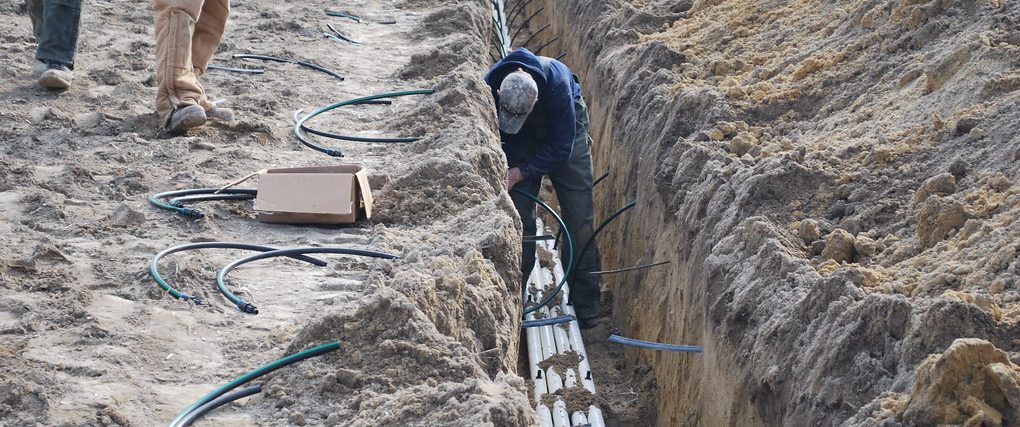
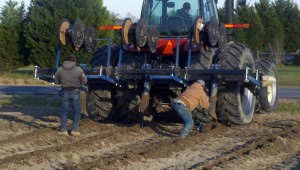
Subsurface drip installation
Given the broad potential impact of SDI technology on Delaware agriculture, a cooperative project to create a SDI research facility was initiated in 2011. Project partners include the University of Delaware with USDA-NRCS, Delaware Department of Agriculture, Toro Ag, John Deere Water, Sussex Irrigation and Vincent Farms. The installation of a 42 zone sub-surface drip irrigation research station on a 20-acre parcel of the University of Delaware’s Warrington Irrigation Research Farm in Harbeson, DE, began in December 2012. This facility will enable the University of Delaware to research specific questions regarding the installation, maintenance and management of these systems for 15 to 20 years and generate localized recommendations for Delaware producers.
As is typical with the introduction of a technology new to a region, several questions have arisen regarding the best ways to implement and manage SDI technology for Delaware conditions. Questions involving installation parameters such as drip tape row spacing, depth of placement and flow rates can be partially addressed utilizing research experience from other regions combined with a site specific soil profile. However, most of the unanswered questions involve management strategies such as, determining crop water needs, ideal soil moisture sensor placement, planting configuration, pulsed irrigation and crop establishment. These strategies are more difficult to address and require intensive local field research. The sole purpose for the creation of this SDI research facility is to develop the management recommendations essential to continue the successful adoption of this technology.
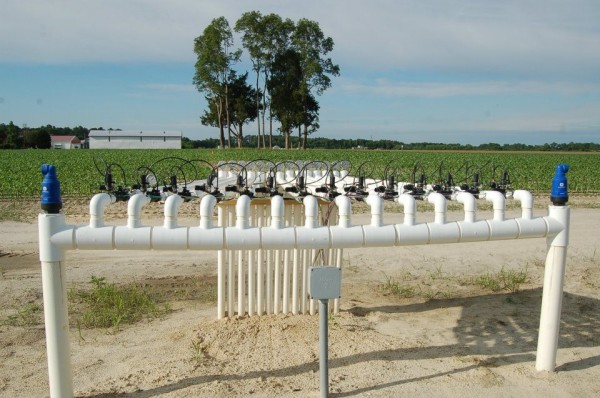
System design
- 1 – 450 gallon per minute well with submersible pump controlled by a variable frequency drive to maintain constant pressure over varying flowrates.
- 42 individual computer controlled irrigation zones.
- 1 – 2 zone, tape placement study with tape installed at 10” & 16” depths on 30” and 60” row spacings.
- 2 – 20 zone irrigation management study areas; each capable of randomizing four replications of five different irrigation treatments in two different crops. The tape will be installed at the typical Delaware SDI installation parameters of 16” deep on 60” rows.
- Average zone dimensions will be 60’ x 300’ (approximately 0.41 acres).
- Soil moisture monitoring utilizing an extensive Irrometer Watermark 950T and 950R wireless data logger network.
